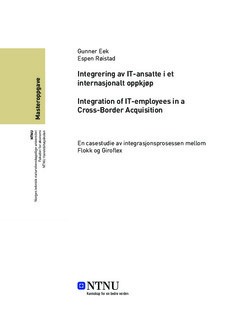| dc.description.abstract | I dagens bedriftsmarked foregår det mange oppkjøp med en påfølgende integrasjonsprosess, hvor det i de siste årene har vært et økt fokus på integrasjon av IT-funksjoner. Litteraturen deler integrasjonsprosessen opp i to deler; den tekniske integrasjonen og den menneskelige integrasjonen. For å få til den menneskelige integrasjonen kan det tenkes at det vil være en fordel å ha en god relasjon mellom virksomhetene. Dagens forskning sier lite om hvordan en oppkjøpt virksomhet opplever integrasjonsprosessen, og hvordan ulike faktorer påvirker deres opplevelse. Derfor har denne studien tatt for seg integrasjonsprosessen sett fra oppkjøpt virksomhet sitt ståsted. Problemstillingen: “Hvordan opplever IT-avdelingen i en oppkjøpt virksomhet integrasjonsprosessen etter et oppkjøp og hvordan påvirker integrasjonsarbeidet relasjonen mellom virksomhetene?” har vært utgangspunktet i studien der selve problemstillingen har hatt et todelt formål. Første formål gikk på oppkjøpt virksomhets opplevelse av integrasjonsprosessen, mens det andre formålet så på utviklingen av relasjonen mellom to parter.
For å finne svar på ble det gjennomført en casestudie av en full integrasjon mellom møbelprodusenten Flokk gjorde av konkurrenten Giroflex. Studien gjennomførte til sammen syv kvalitative semistrukturerte intervjuer. I tillegg ble det gjort en grundig innsamling av teori knyttet til integrasjonsprosessen, der det ble valgt fire menneskelige faktorene som skulle beskrive oppkjøpt virksomhets opplevelse: kommunikasjon, kultur, usikkerhet og tillit. Mens relasjonsutviklingen ble sett på etter prinsippene i Håkanssons og Snehotas (1995) ARA- modell.
Studien viser at oppkjøpt virksomhet opplevde en usikkerhet i begynnelsen av prosjektet. Men god kommunikasjon og lik kultur mellom virksomhetene styrket tilliten den oppkjøpte virksomheten fikk til kjøper, samtidig som usikkerheten ble redusert. Opplevelsen av disse fire faktorene kan ses i sammenheng hvor de påvirker hverandre og dette påvirket oppkjøpt virksomhet til en opplevelse av en positiv integrasjonsprosess. Studien viser også at partene har opplevd en god relasjon mellom dem. Der aktørbånd har vært den sterkeste dimensjonen i Håkansson og Snehotas (1995) ARA-modell. Selv om både aktivitetslenker og ressursbånd også tydelig har bidratt til å styrke relasjonen. De tre dimensjonene har blitt styrket gjennom integrasjonsarbeidet mellom partene. Dette har skjedd gjennom blant annet god og jevnlig kommunikasjon, fysisk interaksjon, kunnskapsutveksling og samarbeidsoppgaver. | |
| dc.description.abstract | In today’s corporate environment, there are several integration processes in play following corporate acquisitions. In these processes, there has been an increased focus on IT-system integration in the past few years. Academic literature divides the integration process into two parts; technical and human integration. In order to succeed in the human integration, a positive relationship between the two sides prior to acquisition appears to be of benefit. Contemporary research hardly addresses how an acquired company experiences the integration process, as well as how various factors affect their experience. Therefore, this study takes the view of the acquired company when analysing the post-acquisition integration process. The question “How does the IT department of an acquired company experience post-acquisition integration processes, and how does the integration effort affect the relationship between the two companies?” has been the basis of this study. The purpose of the question was two-fold. Firstly, to discuss the experience of the acquired company, and secondly, to look at the developments in the relationship between the two sides through the integration process.
To answer this two-fold question, a case study has been conducted of furniture manufacturing company Flokk’s acquisition of competitor Giroflex, after which a full integration process was conducted. In the study, seven qualitative, semi-structured interviews were conducted. Additionally, a thorough analysis of theory surrounding the integration process was conducted, where the four human factors describing the acquired company’s experience were: communication, company culture, uncertainties and trust. Meanwhile it was decided that developments in the relationship between the two parties was to be viewed through the principles in Håkansson and Snehota’s (1995) ARA model.
The study shows the acquired party experienced uncertainty in the beginning of the project. However, good communication and strong similarities in the company cultures of the two sides strengthened the trust in acquired side towards its new parent company, as well as reduced uncertainties to some degree. The experience of these four factors can be seen in relation to how they affect each other, and the integration process was to the acquired company felt as a positive process. The study also shows the two parties have experienced the relationship between them as positive. Although actor bonds has been the strongest dimension of Håkansson and Snehota’s (1995) ARA model, activity links and resource ties have also clearly contributed to strengthening the relationship. These three dimensions have been strengthened through the integration effort. This has happened, among other reasons, through good and regular
iii
communication, physical interaction between employees, exchange of knowledge and tasks for which cross-company cooperation has been necessary. | |
